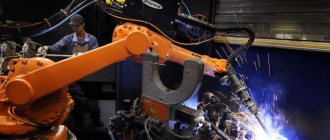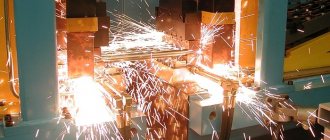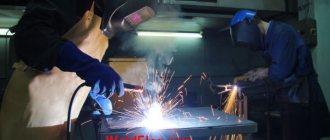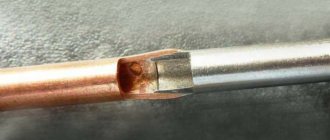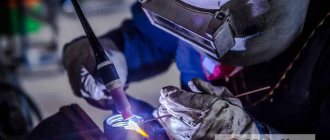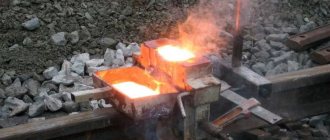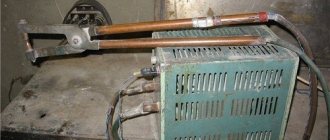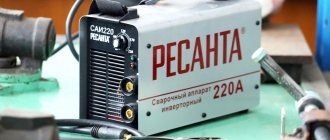Robotic welding is a type of automated process characterized by high precision. Programmable robots replace welders and increase work productivity tenfold. A welding robot is an essential part of a conveyor production where there are welding operations. For example, when assembling cars, household appliances, equipment.
The essence and application of robotic welding
Robots perform welding work for many hours. They don't need lunch breaks. Some models operate during power outages or network sag. Robotic welding is effective for large volumes. Before the welding operation, robots correctly position the parts and install them with the required clearance. They do this with a manipulative hand much more accurately than a human. The seam is smoother. The size of the part does not matter for robotic welding, the “arm” can be adjusted to any distance.
With the help of robots, metal is welded and cut; spot, electric arc, and argon welding are more often used; it is permissible to form a welded joint using flux. Manipulators create a uniform seam bead, mechanization eliminates the human factor, there is no need to monitor the melt pool, an arc of several millimeters is maintained automatically. The gasket is not affected by the position of the workpiece grip; the grip deviation does not exceed 5 mm.
Welding robots are used in the assembly of cars, household appliances, and equipment. Very often they are used not only to weld, but also to cut metal.
The main advantages of robotization of production
Let us immediately note that we will also dwell on the disadvantages of robotizing production at an enterprise, but there are much fewer of them. So, there are many more advantages from such a process. Let's look at each of them.
Improving enterprise safety
Yes, we will start with security. Although this plus does not directly affect the company’s profit, the safety of production processes is a very important element. The speed and uninterrupted operation of the enterprise depends on it.
The human factor can greatly influence this very security. Welding robots work according to a pre-prepared program. They perform the same type and monotonous actions, do not make mistakes and do not expose the company to the danger associated with fatigue and simple inattention.
Increased work speed
On average, according to the many years of experience of KIMAST specialists, production speed can increase to 60% or higher in certain areas of industry. This plus is one of the most significant in any company, since, along with product sales, the speed of its release directly affects profits.
The speed of production with the help of production robotization can be achieved through night shifts, work on weekends, no breaks and uninterrupted operation of equipment.
Improving product quality
The highest precision of modern industrial robots and repeatability of actions can ensure high quality products at all times. Unlike workers, technicians practically cannot make mistakes, due to the presence of internal monitoring systems for the operation of the welding robot and an immediate response to deviations by stopping the process.
Improving working conditions
One of the factors in attracting qualified specialists is the working conditions created at the enterprise. The more attractive they are, the more highly qualified personnel you can attract.
When working with modern industrial robots, many enterprises are becoming very high-tech companies. Workplaces become safer and cleaner.
Reducing wage costs
By automating production processes, it is quite possible to eliminate some of the connecting jobs in the enterprise. Thereby reducing the human factor and reducing the wage fund.
Of course, firing employees does not add to the prestige of the company, but the world does not stand still, and you can focus on more technologically advanced jobs.
For example, if previously it was necessary to use 3 specialists to produce one part, now you can reduce this process to 1 specialist and a welding robot. And spend the saved money on attracting personnel to the sales department or the website development department.
Reduced footprint
Installing robotic systems at an enterprise can, in certain situations, reduce the occupied space. Since modern welding robots are becoming more technologically advanced, smaller and faster.
Welding robot device
An automated device is an apparatus mounted on a solid base with an articulated rotating mechanism. The body rotates freely around its axis. The welding robot is equipped with:
- current source;
- current-voltage characteristics converter;
- feeding device.
A display, a remote control with software, and an inert gas cylinder are provided. The controlled “arm” consists of several parts. From three to six segments are connected by rotary units. A gas burner is attached to the end of the manipulator arm, an additive - welding wire - is automatically supplied to the working area, and a protective atmosphere is created by supplying gas.
What are the different welding methods?
It is customary to distinguish several types of welding:
- Point-contact. One of the most common. For this type of welding, the device is equipped with special pliers. The most common type.
- Dugovaya. It has also become widespread. However, this type requires a greater number of degrees of freedom so that the welding head is positioned strictly perpendicular to the seam.
- By friction and movement method. A welding robot spins a tool - a rod. A special tip is installed in it. Welding occurs by heating the element to high temperatures. The robot moves smoothly along the entire welding line.
- Laser. Used for high speed welding. Practically does not emit caustic substances into the atmosphere.
- Ultrasonic. Most often used in welding integrated circuits. The welding head consists of a waveguide, an ultrasound generator, and a welding needle.
To ensure that the process goes faster and the welding accuracy does not deteriorate, you need to properly organize the workspace.
Advantages and disadvantages
Robotic welding optimizes the technological process; robotic machines have replaced welders. Advantages of work automation:
- the quality of connections improves;
- similar operations are performed at the same speed (a person is not capable of this);
- equipment can be reconfigured during operation in a matter of minutes;
- the defect rate decreases;
- stable arc burning is maintained, the interval between the workpiece and the electrode is maintained;
- the operating time is much longer;
- equipment costs quickly pay off due to the elimination of manual labor and increased productivity;
- maintenance costs are disproportionately less than the salary fund of welders with mandatory deductions;
- the operator setting up the equipment acts according to modified algorithms that do not require special knowledge; it does not take long to train him;
- safety - no thermal or radiation effects on people;
- economic effect;
- no control system is needed; this function is performed by a computer.
Now about the disadvantages, they also exist:
- high cost of robots;
- repeatability of operations, you won’t be able to reconfigure the automation, robotic welders are used only in conveyor assembly and mass production;
- The quality of welding work depends on the operator’s experience and ability to set up equipment.
How to achieve robotic welding precision?
There are four ways to increase the accuracy of work:
- Elimination of inaccuracies in the assembly of robot joints, correction of errors in zero sensors, which are responsible for the angles of rotation of the robot joints. To reduce the effect of these factors to a minimum, you need to use special software that takes into account such errors.
- Entering G-codes. Using special programs that correctly convert three-dimensional CAD/CAM files into G-codes.
- Reduction of microvibrations. They occur due to the use of low-backlash gearboxes in robots. Sometimes micropulses occur, which can affect the accuracy of welding. Leading manufacturers take this factor into account. They include in the program code “a method of additional signals in the motor inertia moment command.” This reduces the amount of vibration and resonance to zero.
- Control of the robot's coordinate system. Special program code that takes into account the displacement of the tip of the welding machine after finishing work. Also known as the "tool measurement method".
And the most important thing is timely maintenance and regular maintenance of the automatic welding device.
Types of welding robots
Robotic models for welding have been developed and produced:
- consumable electrode;
- welded wire;
- tungsten and graphite rods;
- contact copper-containing electrodes (spot welding);
- plasma;
- laser.
Some manufacturers have launched the production of hybrid modifications. The main differences between welding robots:
- manipulator length;
- the number of repeated parts in the “arm”;
- functions performed.
Accuracy of work execution
Robot spot welding has long been a recognized method, because the required positioning accuracy using this technology is only 1 mm, which was already available to the first generation of robots. Arc welding requires much tighter tolerances compared to contact welding, since the change in the position of the arc should not be more than 0.5 mm.
High precision of robot welding is ensured by error-free oscillatory movements of the torch, however, in order to achieve ideal repeatability when using the robot in production, a number of requirements must be met:
- Ensuring high positioning accuracy of all welding units
- Ensuring the stability of weld joints
- Using only the highest quality welding materials.
Equipment setup
Welding robots include stages of setting up robotic equipment:
- Calibration of the external axes of movement of the robotic manipulator when installing in position. The operator checks the operating mode indicators on the display: seam length, trajectory. The shape of the weld seam depends on the accuracy of the installation of the external axes. Deviations of a few millimeters lead to defects.
- Setting up the “hand” with the tool, coordinating the movements of the welding head substrate and the clamping mechanism. They must move in concert, otherwise the welding will not be on the workpiece, but on the movable clamping mechanism or manipulator.
- Environment coordination. Typically, several welding robots are installed on a conveyor at once; they should not interfere with each other. A model of the welding process is created together with other robotic manipulators working in parallel.
The first two settings are required after connecting the robotic welding equipment to the network in order to install it correctly.
Pre-calibration by default. Conducted by factory operators. Welding ports and clamping mechanisms are calibrated to microns when interacting.
3. The main disadvantages of robotization of production
As you know, every coin has a reverse side. Fortunately, in the field of robotization of production, the disadvantages greatly outweigh the advantages and are even strained. But we still have to sort them out.
Need for staff training
When working with modern technology, it is necessary to train staff in new skills. Of course, if people worked on manual or semi-automatic welding machines, they will not be able to immediately work on high-precision welding robots and complexes.
In any case, you need to set aside time and budget for staff training. But there is a nuance here that for some reason enterprises do not pay due attention to. This is attracting young people to work. Since young people are more adapted to modern technologies, this can be a good impetus for updating and rejuvenating the company’s personnel.
There may be a need for reconstruction of the premises
Not every room in which the company worked can be converted to install welding robots and robotic systems, since there are certain technological recommendations and requirements.
But this is also not a big problem, since finding new premises is not so difficult and this only leads to the expansion of the company and its development.
Costs for installing and configuring equipment
As with any new process, a one-time amount will be required for the purchase and configuration of equipment. In the future, of course, this will pay off and bring even more profit.
But you may have to set aside a budget for staff training, payment for reconfiguration and redevelopment of the workshop. But this is a contribution to the development of the company and cannot be considered a direct loss of funds. This is an investment in the future.
Placement of a robotic welding complex
When installing a robotic welding complex into a working position, a number of rules are observed:
- the thickness of the concrete floor is at least 30 cm;
- surface irregularities greater than 5 mm are not acceptable;
- fixation is carried out with removable anchor bolts, eliminating shift due to vibration;
- the work area is fenced off with warning tape or portable yellow fence panels;
- the size of the security zone is at least 1.5 meters;
- provision is made for connecting an overhead wire to cool the connection;
- electrical wiring is laid in metal cable channels.
The software is configured only after the robot has been positioned.
Conclusion and recommendations
Thus, we tried to indicate all the pros and cons of robotizing production or installing welding systems to automate processes in an enterprise.
As stated, there are many more advantages from such a decision, and they are more significant than the disadvantages . To briefly summarize, we can highlight the advantages and disadvantages of robotization of production:
Advantages of robotization of production:
+ Increased security in the enterprise
+ Increased work speed
+ Improving product quality
+ Improving working conditions
+ Reduced wage costs
+ Reduced footprint
Disadvantages of robotization of production:
— Need for staff training
— There may be a need for reconstruction of the premises
— Costs for installing and configuring equipment
In general, to solve serious problems, we recommend paying attention to proven and high-quality equipment from YASKAWA. We have been working with them for a long time and the quality of their products is constantly improving. You can evaluate and select the necessary models of robots and welding systems in our catalog.
The decision is up to you, but it is worth noting that competition in the field of standard products is growing and you need to follow the trends. Many companies are already automating their production processes.
SEND YOUR APPLICATION
Service maintenance. A basic level of
The target audience
Operators, maintenance specialists, service technicians
Course Objectives
After completing the course, your employees will:
- Organize the process of proper operation of the robot
- Correctly formulate a request to Kawasaki Robotics support service
Content
- Inspection and maintenance schedule
- Saving a backup copy of programs and error logs
- Remote access to the robot
- Troubleshooting
- Formation of a competent request to the service department
- Final tests and certificate issuance
Information
- Duration: 1 day
- Requirements for trainees: Basics of safe robot control
Specialized courses
In addition to the core courses, we can offer specialized courses tailored to your individual needs. For example, for such additional options as:
- K-Vision technical vision system
- Conveyor tracking system
- Cubic-s robot motion control safety system
- Connecting additional axes
- Specialized options for welding, painting, etc.
You can find out the conditions for special courses by contacting our Training Center by phone or email
Increase your enterprise productivity
Welding automation is a process that improves the quality of a production line and speeds up the production process. By introducing robotic welding at an enterprise, the owner saves on labor and increases productivity by reducing the amount of scrap produced.
Thanks to increased productivity, it is possible to quickly recoup the funds invested in automation and gain profit. Each robotic arm can be configured individually so that it performs the type of work that is needed specifically at a particular enterprise. If you still have questions about production automation and the introduction of welding robots into the work of the enterprise, please contact us!
Service maintenance. Electrics. Advanced level
The target audience
Maintenance Specialists
Course Objectives
After completing the course, your employees will:
- Perform independent maintenance of the robot's electrical systems and software
Content
- Replacing boards in the controller
- Replacing and initializing Main CPU
- Software Update
- Replacing wiring
- Final tests and certificate issuance
Information
- Duration: 2 days
- Requirements for trainees: Service. A basic level of
Programming. A basic level of
The target audience
Design engineers, adjusters, operators, programmers of robotic systems
Course Objectives
After completing the course, your employees will:
- Have basic block programming skills
- Have basic AS programming skills
Content
- Saving a backup copy of programs and error logs
- Restoring from a backup
- Block programming
- AS programming (basics)
- Final tests and certificate issuance
Information
- Duration: 1 day
- Requirements for trainees: Basics of safe robot control
Service maintenance. Mechanics. Advanced level
The target audience
Maintenance Specialists
Course Objectives
After completing the course, your employees will:
- Carry out independent maintenance of the mechanical components of the robot
Content
- Brief overview of the basic service course
- Replacing batteries
- Lubricant replacement
- Restoring functionality after service work
- Replacing engines
- Replacing the encoder
- Final tests and certificate issuance
Information
- Duration: 2 days
- Requirements for trainees: Service. A basic level of
Training course description table
| Course name | Requirements for trainees | The target audience | Course duration |
| Basics of Safe Robot Control | No | All | 1 day |
| Programming. A basic level of | Robot Control Basics | Design engineers, adjusters, operators, programmers of robotic systems | 1 day |
| Service maintenance. A basic level of | Robot Control Basics | Operators, maintenance specialists, service technicians | 1 day |
| Programming. Advanced level | Programming. A basic level of | Design engineers, adjusters, programmers of robotic systems | 3 days |
| Virtual modeling systems K-Roset and K-Sparc | Programming. A basic level of | Design engineers, adjusters, programmers of robotic systems | 2 days |
| Service maintenance. Mechanics. Advanced level | Service maintenance. A basic level of | Maintenance Specialists | 2 days |
| Service maintenance. Electrics. Advanced level | Service maintenance. A basic level of | Maintenance Specialists | 2 days |
